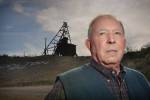John Sealy Livermore, geologist whose hunch struck gold, dies at 94
His was the eureka moment that launched the world's modern-day gold rush.
When geologist and prospector John Sealy Livermore staked a few claims for Newmont Mining Corp. in the Northern Nevada desert in 1961, it was based partly on a hunch. You couldn't see any gold, but Livermore's intuition, knowledge of geology and exploration told him the land was laced with microscopic bits of the precious metal. Livermore was definitely on to something: He discovered the Carlin trend, a five-mile-by-40-mile ore body that ranks today as one of the world's richest gold veins.
Livermore, whose microscopic-gold strike revolutionized the mining industry, died of cancer Thursday at his Reno home. He was 94.
"There's that saying that special people see common things in uncommon ways, and he was able to look at the landscape and say, 'There's something here,' " nephew Dave Livermore said. "This was the same country that the original 49ers walked right over, and they had no idea there was gold in it."
But Livermore - a voracious reader who never owned a TV - read constantly about discoveries in other sciences, said Andy Wallace, Livermore's partner in the exploration company Cordex. His ability to synthesize information to draw a bigger picture helped him see what others couldn't, Wallace said. After Livermore's discovery, miners around the world used his theories and methods to find microscopic ore bodies.
Livermore was born in San Francisco on April 16, 1918, and studied geology at Stanford University.
Before he launched his career, Livermore helped build the Basic Magnesium plant in Henderson. After World War II, Livermore was a prospector at the Standard Mine near Lovelock. He began developing his microscopic-gold theory there and took the idea with him when he joined Newmont in 1952.
Since Newmont began digging at Carlin in the '60s, the ore body has drawn dozens of mining companies. By 2008, the trend had produced more than 70 million ounces of gold. It still yields 4 million ounces a year, or roughly $7 billion of gold at today's prices.
It's not overstating the case to say Livermore's microscopic-gold discovery changed the course of mining across the world, said John Dobra, an associate professor of natural resource economics at the University of Nevada, Reno, and director of the university's Natural Resource Industry Institute. Some accounts credit Livermore with discovering four ore bodies, but Dobra thinks Livermore may have found as many as a dozen.
"Most geologists will never discover one ore body," Dobra said.
Livermore worked until he was 92, when he began to lose his balance out in the field, Wallace said. His career took him to South America, the Middle East and Africa. A 1989 New Yorker article described his "extraordinary success ... venerated by both prospectors and geologists."
Senate Majority Leader Harry Reid, D-Nev., also recognized Livermore's contributions.
"John was a tremendous figure in Nevada and he will be sorely missed. He had an unflinching commitment to his family, his work, and his community. His contributions to Nevada have helped to build our state and will endure in years to come," Reid said in a statement.
Despite his success, Livermore lived a modest lifestyle in a one-bedroom apartment in Reno, Wallace said. He donated anonymously to Stanford and UNR. He also cared about conservation, working to modernize the 1872 General Mining Act and promoting reclamation, said Dave Livermore, Utah state director of The Nature Conservancy.
Livermore never married or had children, but he was a father figure to his 13 nieces and nephews, Dave Livermore said.
"He was an unassuming person who loved us, and we loved him a lot. There will be some big shoes to fill in our family," he said.
Wallace saw Livermore for a three-hour lunch about two weeks before he died, and he said Livermore seemed at peace.
"He knew the end was near, but he was comfortable. We laughed about his career, and what a life he had. It was a life most of us could only dream of. He did everything, he went everywhere and he had success."
In addition to his nieces and nephews, Livermore is survived by 17 grandnieces and grandnephews, and his brother, Putnam Livermore.























